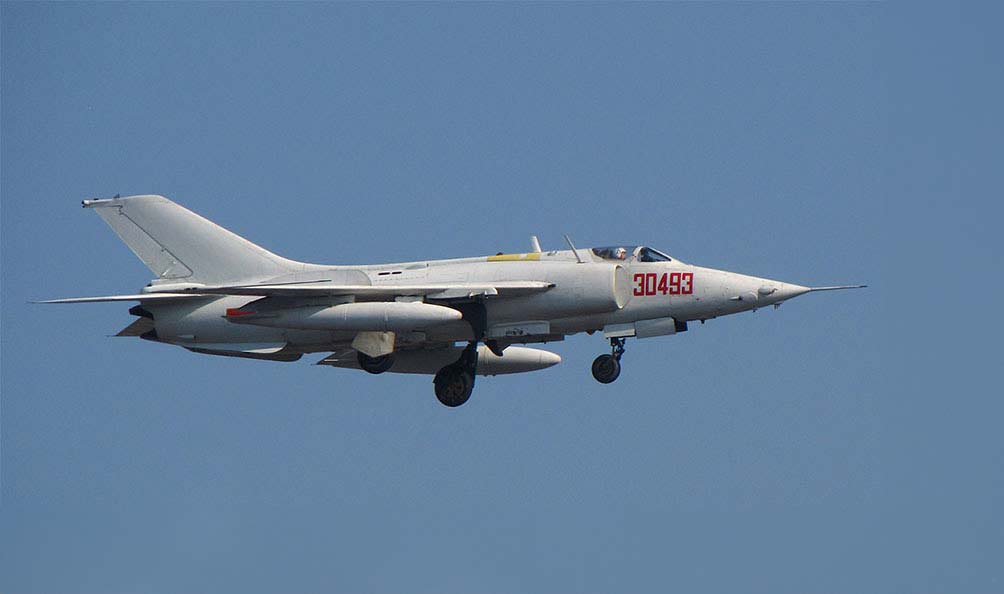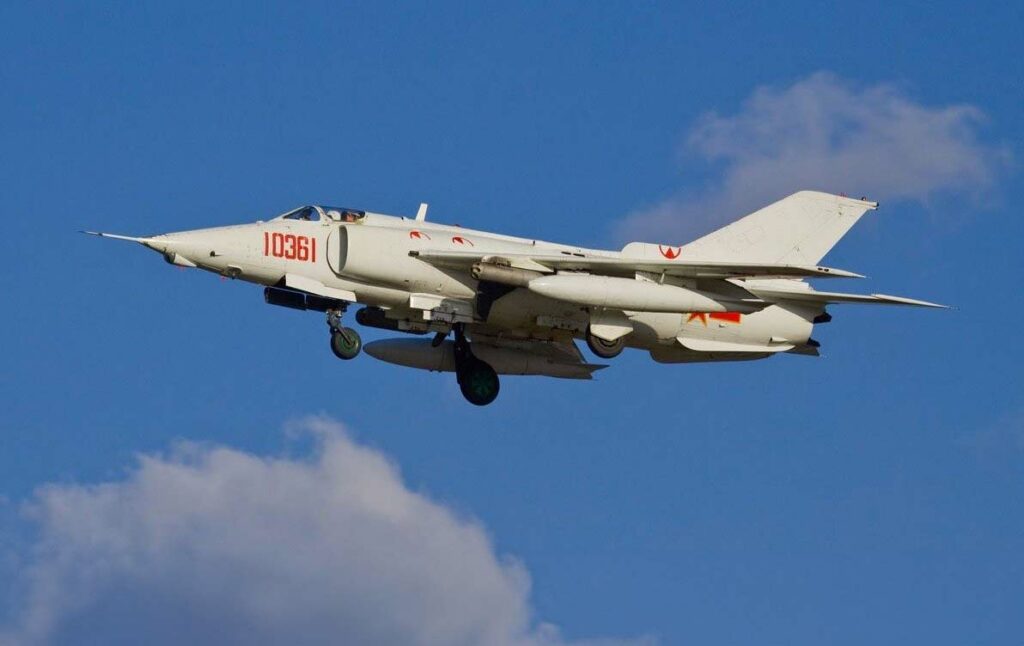The Nanchang Q-5, a twin-engine, jet-powered ground attack aircraft developed by China for the People’s Liberation Army Air Force (PLAAF).
In brief
The Nanchang Q-5, known as “Fantan” by NATO, is a Chinese ground attack aircraft derived from the MiG-19. Its design focuses on low-altitude, high-speed penetration and ground attack missions. Introduced in the 1960s, it features a tandem-seat configuration in some variants, a robust airframe capable of withstanding considerable damage, and provisions for an array of weaponry including rockets, bombs, and guns. Despite its age, upgrades over the years have enhanced its avionics, weapons systems, and engine performance, allowing it to remain a valuable asset in modern warfare contexts.

History of the Development of the Nanchang Q-5 (Fantan)
The Nanchang Q-5, or Fantan, was born out of China’s necessity for a capable ground attack aircraft during the Cold War era, reflecting the strategic shift towards self-reliance in military technology. The inception of the Q-5 project traces back to the late 1950s, when China’s aviation industry was still in its nascent stages, heavily reliant on Soviet designs and technology. The Q-5’s development was propelled by the escalating tension and the growing need for a robust, versatile aircraft capable of delivering precise ground attacks while evading enemy radar and air defenses.
Launched under the auspices of the People’s Liberation Army Air Force (PLAAF) and developed by the Nanchang Aircraft Manufacturer, the Q-5 project was a testament to China’s burgeoning capabilities in aircraft design and manufacturing. Drawing inspiration from the Soviet MiG-19, the design team, led by Chief Designer Lu Xiaopeng, embarked on creating an aircraft that not only exceeded the capabilities of its progenitor in ground attack missions but also incorporated indigenous innovations.
The Q-5 made its maiden flight on June 4, 1965, marking a significant milestone in China’s military aviation history. The aircraft was designed with a focus on low-altitude penetration and ground attack operations, a role that was becoming increasingly important in the context of modern warfare where air superiority was no longer guaranteed.
The designation “Fantan” by NATO came much later as part of its naming convention for aircraft of Soviet or Chinese origin, although the name does not have a particular significance beyond identification purposes.
The development of the Q-5 was a complex process, marred by political turmoil, notably the Cultural Revolution, which disrupted industrial and technological progress across China. Despite these challenges, the development team persevered, driven by the strategic imperative to enhance the PLAAF’s capabilities.
Design of the Nanchang Q-5 (Fantan)
The Q-5’s design is characterized by its swept wings, a reflection of its MiG-19 heritage, optimized for high-speed, low-altitude flight. The aircraft’s airframe was constructed to endure the rigors of low-level flying and ground attacks, incorporating armor plating around vital areas to protect against ground fire. It measures 53 feet in length with a wingspan of 31 feet, translating to 16.1 meters and 9.7 meters respectively, and has a loaded weight of approximately 19,842 pounds (9,000 kilograms).
A significant design feature of the Q-5 was its lack of radar, a decision that streamlined its profile and reduced weight, enhancing its speed and agility at low altitudes. Instead, it relied on ground-based guidance for navigation and targeting, a limitation that was somewhat mitigated in later variants with the introduction of advanced avionics and targeting systems.
The aircraft’s propulsion system is another focal point, featuring two afterburning turbojet engines, which were capable of propelling the Q-5 to speeds exceeding Mach 1.1. This powerplant provided a blend of speed and thrust necessary for swift ingress and egress from target areas, crucial for its role in ground attack missions.
However, the Q-5’s design also had its drawbacks, including limited range and payload capacity compared to contemporary Western designs. These limitations were partially addressed in later variants through the introduction of in-flight refueling capabilities and expanded weapons compatibility, including precision-guided munitions.
Performance of the Nanchang Q-5 (Fantan)
The Nanchang Q-5’s performance metrics are a testament to its design and engineering. With a maximum speed of 1,186 mph (1,909 km/h) at altitude and a service ceiling of 51,500 feet (15,700 meters), the Q-5 was adept at executing its ground attack role efficiently. Its range stood at approximately 373 miles (600 kilometers), extendable with external fuel tanks, allowing for deep penetration into enemy territory.
Powered by two Liming Wopen-6 turbojet engines, each generating up to 6,614 pounds of thrust, the Q-5 could deliver a formidable payload of up to 4,409 pounds (2,000 kilograms) of munitions, including conventional bombs, rockets, and later, precision-guided weapons. This made it a versatile platform capable of engaging a variety of ground targets.
When compared to its contemporaries, such as the Soviet Su-25 or the American A-10, the Q-5 held its own in terms of speed and agility, although it lagged in payload capacity and advanced targeting systems. This gap was progressively narrowed with subsequent upgrades that enhanced its avionics, weapons systems, and overall combat effectiveness.
Variants of the Nanchang Q-5 (Fantan)
The Q-5’s production line saw several variants, each tailored to meet specific operational requirements or to incorporate technological advancements. The initial variants, Q-5A and Q-5B, focused on enhancing payload capacity and introducing dual-seat configurations for training and reconnaissance roles. The Q-5D and Q-5E introduced significant avionics upgrades, including radar and precision-guided munitions capabilities, markedly improving their combat effectiveness.
A notable variant, the Q-5I, was developed specifically for electronic warfare, equipped with advanced jamming and electronic countermeasures systems. Each variant represented a step forward in the Q-5’s evolution, ensuring its relevance on the modern battlefield.

Military Use and Combat of the Nanchang Q-5 (Fantan)
The Q-5’s combat history is marked by its extensive use in various conflicts, serving as a workhorse for ground attack missions across Asia and Africa. Its armament, capable of deploying a wide range of munitions, from conventional bombs to advanced precision-guided missiles, made it a formidable adversary against ground targets.
One of the notable engagements involving the Q-5 was during the Sino-Vietnamese War, where it conducted numerous ground attack missions, demonstrating its capabilities in a combat environment. Its performance in these conflicts underscored the aircraft’s reliability and effectiveness, even when pitted against more modern adversaries.
The Q-5 has also seen service with several other nations, including Pakistan, Bangladesh, and Sudan, indicating its appeal as a cost-effective ground attack solution. The aircraft’s export success further cemented its position in the international arms market, providing valuable military capabilities to countries seeking to bolster their air forces without the hefty price tag of Western alternatives.
As of the latest reports, the Q-5 continues to serve in a limited capacity within the PLAAF and other air forces, although it is gradually being phased out in favor of more modern platforms. Its retirement is marked by the introduction of next-generation aircraft, equipped with state-of-the-art technology, reflecting the inexorable march of military aviation towards increasingly sophisticated and capable systems.
The Nanchang Q-5, or Fantan, stands as a significant chapter in the annals of military aviation, embodying the technological strides made by China in the latter half of the 20th century. Its development, deployment, and enduring legacy underscore the aircraft’s role in shaping modern aerial warfare strategies, particularly in the realm of ground attacks. As the Q-5 gradually exits the world stage, its contribution to military history and its role in the evolution of combat aircraft will not be forgotten.
Back to the Fighter Jet section.